Fine Ceramics, sometimes referred to as "advanced ceramics," are engineered materials that support the development of cutting-edge technology.
Heat (1)
Heat Resistance to Withstand Extreme Temperatures
Conventional ceramics, including bricks and tiles, are well known for their ability to withstand high temperatures. Nonetheless, Fine Ceramics (also known as "advanced ceramics") are more heat resistant than these materials by far. While aluminum begins to melt at approximately 660℃ (approx. 1,220℉), alumina Fine Ceramics only begin to melt or decompose at temperatures above 2,000℃ (approx. 3,632℉).
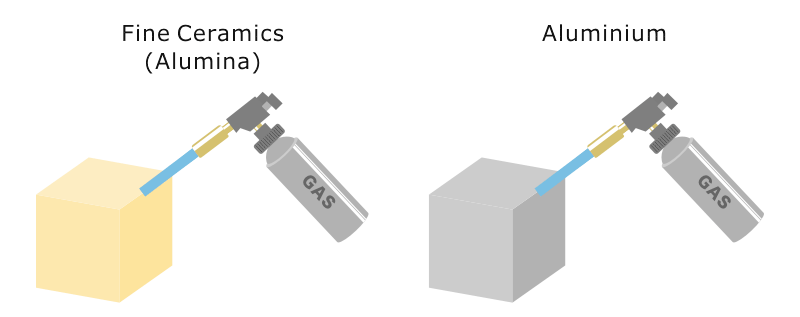
Watch this video to learn about the Heat Resistant properties of Fine Ceramics
Applications: Engine components and foundry / smelting components.
Description
Heat and Thermal Shock Resistance
The heat resistant properties of Fine Ceramics are measured by the temperatures at which they begin to melt, and by their levels of thermal shock resistance. Thermal shock resistance refers to a material's ability to withstand rapid changes in temperature. Silicon nitride, a particularly heat tolerant material, displays superior resistance to thermal shock, as tested by heating the material to 550℃ (1,022℉) and then rapidly cooling it by dropping it into water. Silicon nitride is thus suitable for applications involving extreme temperature variations, and in high-temperature industries such as metal manufacturing and energy generation.
Thermal Shock Resistance (Water Immersion Test)

For more information, please see Excerpt of Graph Values.
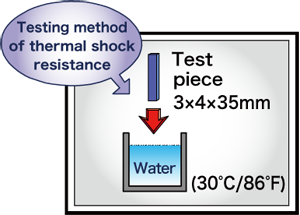
Testing Thermal Shock Resistance
A material's thermal shock resistance is determined by the difference between the peak temperature of the Fine Ceramic which was heated, rapidly cooled, and then fractured, and that of the cooling media. Stresses are generated by temperature differences between the interior and surface of a test piece, which occur during rapid cooling. When these stresses exceed the strength of the Fine Ceramic, fracturing occurs. These temperature differences are determined by the thermal conductivity of ceramics, as well as the coefficient of heat transfer between the Fine Ceramic and the cooling media. In addition, the stresses generated are determined by multiplying Young's modulus, the coefficient of thermal expansion, and the temperature differences between the interior and surface of the Fine Ceramic.
Watch this video to learn about the Thermal Shock resistant properties of Fine Ceramics
The term "Fine Ceramics" is interchangeable with "advanced ceramics," "technical ceramics" and "engineered ceramics." Use varies by region and industry.
People who read this page also read.
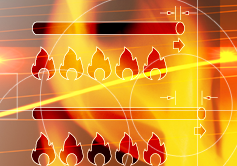
Heat (2)
Heat (2)
Low Thermal Expansion
Low Thermal Expansion
Characteristics of Fine Ceramics
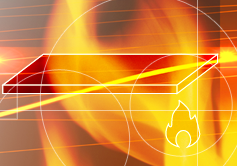
Heat (3)
Heat (3)
Thermal Conductivity Easily Transmits Heat
Thermal Conductivity Easily Transmits Heat
Characteristics of Fine Ceramics
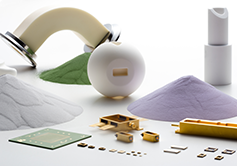
Different Types of Fine Ceramics
Different Types of Fine Ceramics
Wide Variety of Products to Support both Industry and Society
Wide Variety of Products to Support both Industry and Society
Introduction to Fine Ceramics
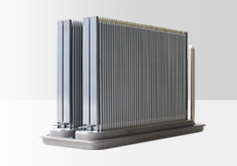
Fine Ceramics Contribute to a Cleaner Environment
Fine Ceramics Contribute to a Cleaner Environment
Ideal for an Eco-Friendly Life with Higher Power Generation Efficiency
Ideal for an Eco-Friendly Life with Higher Power Generation Efficiency
Learning about Fine Ceramics
If you want to use ceramics in business, click here.
Kyocera's Fine Ceramics products (All websites below open in a separate window.)
Product Category
 Semiconductor / LCD Processing Equipment
Semiconductor / LCD Processing Equipment
 Life / Culture / Industrial Machines
Life / Culture / Industrial Machines
 Wireless Communications
Wireless Communications
 Computer Peripherals
Computer Peripherals
 Environmental Preservation / Renewable Energy
Environmental Preservation / Renewable Energy
 Medical Equipment / Devices
Medical Equipment / Devices
 Single-Crystal Sapphire Products
Single-Crystal Sapphire Products
 Metallized / Vacuum Components
Metallized / Vacuum Components
 Electronics Industry
Electronics Industry
 Heaters
Heaters
 Piezoelectric Ceramics
Piezoelectric Ceramics
Search by Material
 Alumina
Alumina
 Silicon Nitride
Silicon Nitride
 Silicon Carbide
Silicon Carbide
 Sapphire
Sapphire
 Zirconia
Zirconia
 Cordierite
Cordierite
 Yttria
Yttria
 Aluminum Nitride
Aluminum Nitride
 Cermet
Cermet
 Mullite
Mullite
 Steatite
Steatite
 Forsterite
Forsterite
Search by Property/Characteristic


- Thermal Properties
- Coefficient of Thermal Expansion
- Thermal Conductivity
- Heat Shock Resistance

- Electrical Properties
- Insulation / Semiconductivity

- Chemical Properties
- Chemical Resistance










